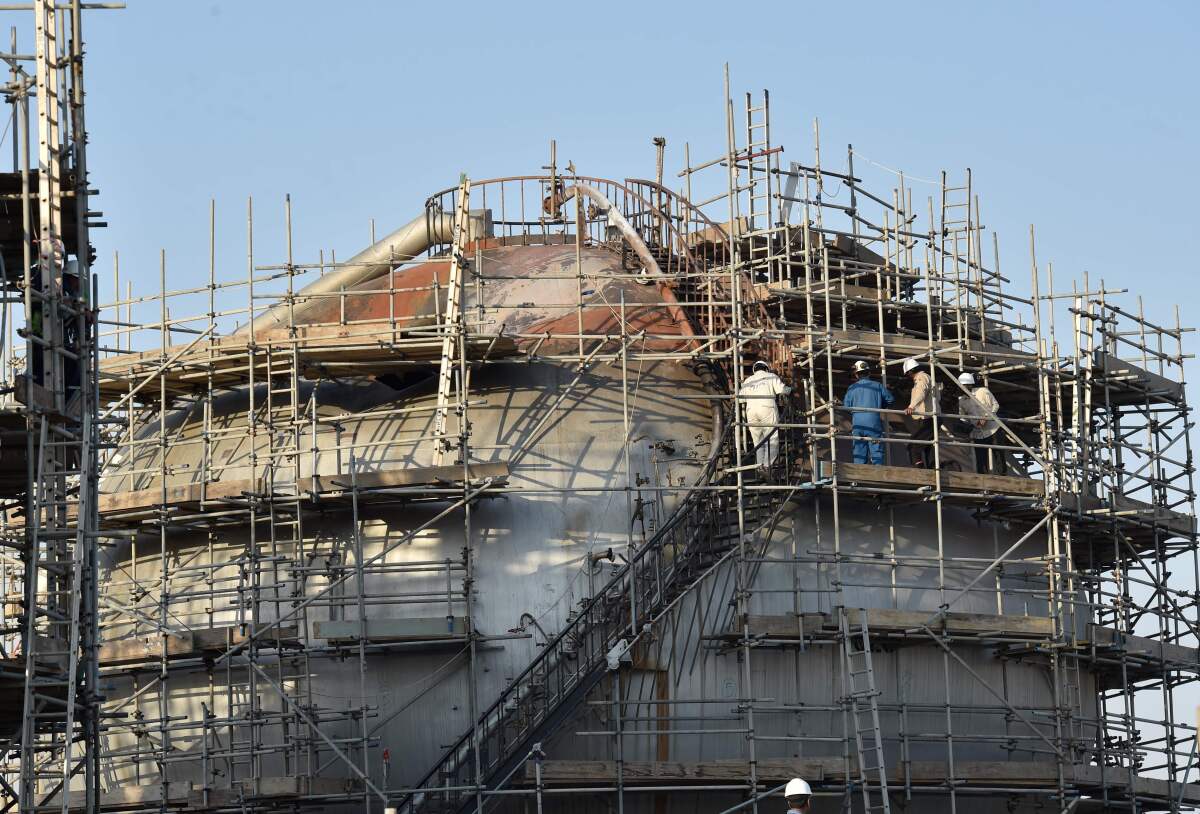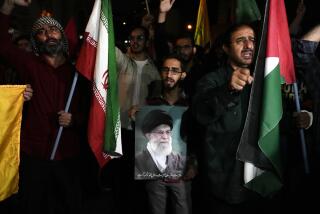Saudi Arabia says itâs âwilling and ableâ to respond to Iran. Is it?

BAGHDAD â In the days after Saturdayâs attack on Saudi Arabiaâs oil facilities, the kingdomâs leaders and officials have kept hammering one message: that Saudi Arabia is willing and able to respond to Iran.
But can it?
Beyond the strident rhetoric from U.S. officials and a steady drip of information that falls short of directly blaming Tehran, Riyadh faces a U.S. president reluctant to go to war on its behalf. Its regional allies, including its top partner in the United Arab Emirates, appear to have little appetite for military adventures, especially after a bruising four-year-and-counting quagmire against Iran-backed Houthi rebels in Yemen.
That means Saudi Arabia would have to be prepared to go to war more or less on its own, just as serious questions are being raised about how effective its forces â and their much-vaunted American-made defenses â would be in a fight against Iran.
On Sept. 14, 25 drones and cruise missiles, according to Saudi defense officials, traveled hundreds of miles from the north and slammed into critical facilities in Khurais and Abqaiq, the worldâs largest oil processing plant, some 200 miles northeast of Riyadh. The strike knocked out half of the kingdomâs crude production, a palpable hit compared with the Houthisâ usual gadfly attacks on airports and facilities near the Saudi-Yemeni border.
Despite the Houthisâ claim of responsibility, both Saudi Arabia and the U.S. insist the level of expertise, not to mention the distance from Houthi-held territory in Yemen, indicated the hand of Iran.
Though the damage was limited -- oil production will return to capacity by the end of September, Riyadh said -- Saudi commentators have likened the attack to Pearl Harbor or 9/11 and demanded retaliation.
The U.S. on Friday said it would send U.S. troops to Saudi Arabia and accelerate weapons deliveries to both Saudi Arabia and the UAE. But Secretary of Defense Mark Esper said the deployments would be âdefensive in nature.â
If Saudi Arabia were to attack, it would likely do so from the air, where it has a clear advantage over Iran, said Fabian Hinz, a research associate at the James Martin Center for Nonproliferation Studies.
âThereâs a stereotype that Saudi forces are really badly trained, but theyâre not the buffoons theyâre sometimes portrayed to be,â Hinz said. He pointed to the kingdomâs air campaign in Yemen, where since 2015 Saudi Arabia has deployed modern strike aircraft with precision-guided munitions and in-flight refueling capabilities to conduct tens of thousands of raids against the Houthis. But it has also resulted in more than 18,500 civilian casualties, according to the Yemen Data Project, which tracks victims of the air war in the country.
âThat they can sustain such a campaign is a testament to the fact they have improved in the air,â Hinz said.
And even though Iran has Russian-made missile defense systems at its disposal, said Michael Duitsman, a missile expert at the James Martin Center, their numbers are unclear.
But Iran wouldnât have to rely only on missile defense. It has allies and proxies it could mobilize at the first sign of an escalation. Theyâre present in Iraq, which shares an almost 500-mile border with Saudi Arabia, and in border areas Yemen shares with the kingdom. If the groups escalate their activities in the Red Sea and the Persian Gulf, Saudi Arabia would be hemmed in from all sides by factions with weapons similar to the ones used in Abqaiq.
Although Saudi Arabia deploys modern variants of the U.S.-built Patriot missile defense system, itâs unclear how effective it is against swarms of drones and cruise missiles like the ones deployed in Abqaiq, experts say.
âAgainst an aircraft, like a fighter or bomber, the Patriot is quite accurate, but low-flying targets give you less warning time, and smaller targets are harder to detect,â Duitsman said, adding that the drones used in the attack were only slightly bigger than a bird.
Long-range radar systems would also have to provide early warning to let air defense radar know where to look. (Saudi Arabia has been lambasted for reports that the Patriotsâ radars were pointing in the wrong direction during the Abqaiq strike.)
Even if everything worked perfectly, Iran could overwhelm any defense system by lobbing everything it had against it. The Houthis claimed to have done just that in Saturdayâs strike, sending in decoy drones to trick air defenses while the cruise missiles struck.
âThe defense world is still figuring out how to deal with this sort of attack,â Duitsman said.
Thereâs also a grim calculus at play: Saudi Arabia simply has more to lose.
The strike on Abqaiq and Khurais exposed how vulnerable the kingdomâs critical oil infrastructure is. It was a realization quickly reflected in the jitters that afflicted crude prices. Riyadh is also trying to recast its image as a place ripe for investment opportunities; drones and cruise missiles hardly help.
Thatâs not the case for Iran. The Trump administrationâs so-called maximum pressure campaign has already devastated its economy and denied it access to most oil markets. Its tanker fleet has faced harassment and restrictions in most parts of the globe.
With U.S. troops stationed in Saudi Arabia, any confrontation with Iran means they too would enter the fray -- making real Iranian Foreign Minister Javad Zarifâs assertion in an interview with CNN this week that the Saudis were willing to fight Iran âto the last American.â
And if an attack were to happen, said Zarif, Iranâs response would be one thing: âall-out war.â
More to Read
Sign up for Essential California
The most important California stories and recommendations in your inbox every morning.
You may occasionally receive promotional content from the Los Angeles Times.











